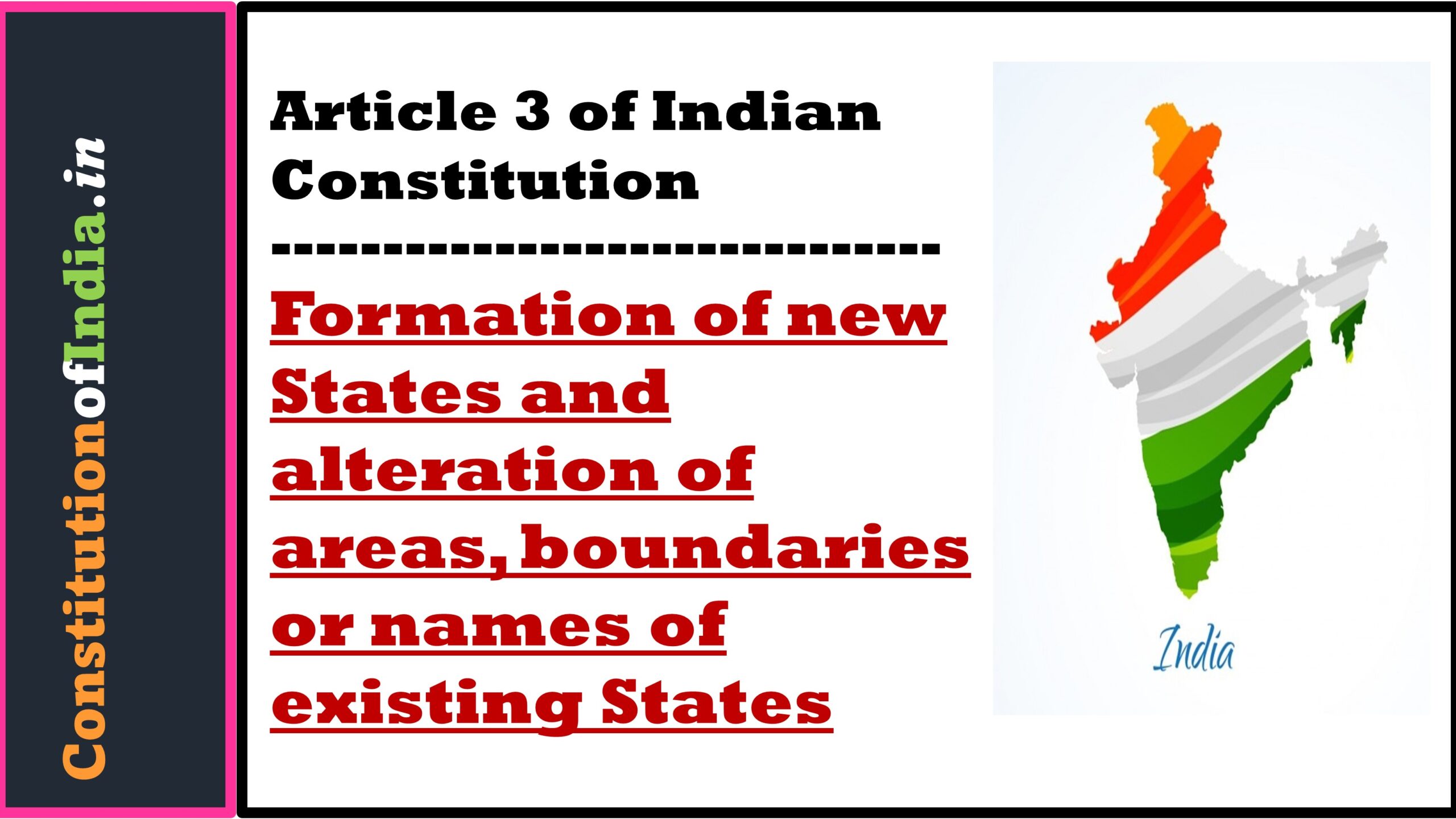Article 3 of Indian Constitution: नए राज्यों का निर्माण और वर्तमान राज्यों के क्षेत्रों, सीमाओं या नामों में परिवर्तन–

Article 3 नए राज्यों का निर्माण और वर्तमान राज्यों के क्षेत्रों, सीमाओं या नामों में परिवर्तन–
संसद, विधि द्वारा–
(क) किसी राज्य में से उसका राज्यक्षेत्र अलग करके अथवा दो या अधिक राज्यों को या राज्यों के भागों को मिलाकर अथवा किसी राज्यक्षेत्र को किसी राज्य के भाग के साथ मिलाकर नए राज्य का निर्माण कर सकेगी;
(ख) किसी राज्य का क्षेत्र बढ़ा सकेगी;
(ग) किसी राज्य का क्षेत्र घटा सकेगी;
(घ) किसी राज्य की सीमाओं में परिवर्तन कर सकेगी;
(ङ) किसी राज्य के नाम में परिवर्तन कर सकेगी:
[परंतु इस प्रयोजन के लिए कोई विधेयक राष्ट्रपति की सिफारिश के बिना और जहाँ विधेयक में अंतर्विष्ट प्रस्थापना का प्रभाव 5राज्यों में से किसी के क्षेत्र, सीमाओं या नाम पर पड़ता है वहाँ जब तक उस राज्य के विधान-मंडल द्वारा उस पर अपने विचार, ऐसी अवधि के भीतर जो निर्देश में विनिर्दिष्ट की जाए या ऐसी अतिरिक्त अवधि के भीतर जो राष्ट्रपति द्वारा अनुज्ञात की जाए, प्रकट किए जाने के लिए वह विधेयक राष्ट्रपति द्वारा उसे निर्देशित नहीं कर दिया गया है और इस प्रकार विनिर्दिष्ट या अनुज्ञात अवधि समाप्त नहीं हो गई है, संसद के किसी सदन में पुरःस्थापित नहीं किया जाएगा।
[स्पष्टीकरण 1 – इस अनुच्छेद के खंड (क) से खंड (ङ) में, ”राज्य” के अंतर्गत संघ राज्यक्षेत्र है, किंतु परंतुक में ”राज्य’’ अंतर्गत संघ राज्यक्षेत्र नहीं है।
स्पष्टीकरण 2–खंड (क) द्वारा संसद को प्रदत्त शक्ति के अंतर्गत किसी राज्य या संघ राज्यक्षेत्र के किसी भाग को किसी अन्य राज्य या संघ राज्यक्षेत्र के साथ मिलाकर नए राज्य या संघ राज्यक्षेत्र का निर्माण करना है।
FAQs on Article 3 of the Indian Constitution
Q1: What is Article 3 of the Indian Constitution about? ‘
Article 3 of the Indian Constitution deals with the power of the Parliament to form new states, alter the boundaries of existing states, or change the names of states.
Q2: What is the purpose of Article 3?
The purpose of Article 3 is to provide a constitutional mechanism for reorganizing states in India to better accommodate the aspirations and interests of different regions or communities.
Q3: What powers are granted to the Parliament under Article 3?
Article 3 grants the Parliament the power to:
- Form new states by separating territories from existing states.
- Merge two or more states or parts thereof to form a new state.
- Alter the boundaries of existing states.
- Change the name of any state.
Q4: Can the Parliament create new states without the consent of the affected states?
No, the Parliament cannot create new states without the consent of the affected states. The consent of the state legislatures involved is necessary for the formation of new states or alteration of boundaries.
Q5: How is the consent of the affected states obtained under Article 3?
The President of India seeks a proposal from the concerned state legislature(s) and refers it to the Parliament. The proposal is then discussed and approved by both houses of Parliament. If approved, the President gives his/her assent, and the new state or altered boundaries come into existence.
Q6: Can the Parliament alter the boundaries of states arbitrarily?
No, the Parliament cannot alter the boundaries of states arbitrarily. The alteration of boundaries must be based on proper consultation, discussions, and the consent of the affected state legislatures.
Q7: Are there any limitations or conditions specified in Article 3 for forming new states or altering boundaries?
Yes, there are certain limitations and conditions outlined in Article 3, such as maintaining the integrity and security of India and considering the linguistic and cultural factors of the regions involved.
Q8: Can Article 3 be amended?
Yes, Article 3 can be amended through the constitutional amendment process, which requires the approval of both houses of Parliament and ratification by the majority of state legislatures. However, any amendments should be consistent with the principles of federalism and the interests of the affected states.
Q9: Has Article 3 been used in the past to reorganize states?
Yes, Article 3 has been utilized in the past to reorganize states in India. Examples include the formation of new states like Telangana, Uttarakhand, and Chhattisgarh, as well as alterations in state boundaries.
Q10: Are there any legal challenges to the exercise of power under Article 3?
There have been instances where the exercise of power under Article 3 has faced legal challenges, particularly concerning the validity of the consent obtained or the manner in which reorganization was carried out. These challenges are dealt with by the judiciary, which ensures adherence to constitutional provisions and principles.
Read Here:
Article 4 of Indian Constitution in Hindi
पहली अनुसूची और चौथी अनुसूची के संशोधन तथा अनुपूरक, आनुषंगिक और पारिणामिक विषयों का उपबंध करने के लिए अनुच्छेद 2 और अनुच्छेद 3 के अधीन बनाई गई विधियाँ